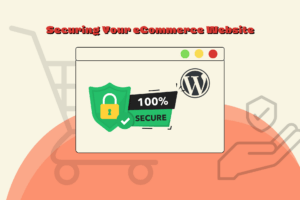How to Create an Ecommerce Website with WordPress
Creating your very own ecommerce website with WordPress? Now, that’s a journey worth taking! In a world where everything’s gone digital, having your business online is like having a storefront that never sleeps. And guess what? WordPress is your trusty sidekick for this adventure because more than 810 million websites use WordPress, which is 43% of all the websites on the internet. So, get ready for a step-by-step ride as we guide you through the process. Whether you’re a seasoned pro or just dipping your toes into the online business waters, this guide is here to make your eCommerce dreams come true. Let’s dive in and make your mark in the digital marketplace!
Why to Choose WordPress for E-Commerce
Choosing WordPress for your e-commerce venture offers a myriad of benefits that contribute to its popularity. With thousands of templates and the flexibility provided by plugins, you can tailor your online store to match your unique brand identity. 20.2% of WordPress sites and 8.8% of all websites use WooCommerce, which means there are over 163.5 million WooCommerce stores.The vast user community ensures robust support through forums and Facebook groups. What sets WordPress apart is its scalability – whether you’re just starting or experiencing growth, it seamlessly adapts to your needs. No need for a disruptive migration to a new platform as your business expands. This makes it an ideal choice for businesses focused on gradual sales growth, eliminating the hassle of platform transitions.
Choosing the right WordPress hosting

Choosing the right WordPress hosting for your ecommerce business is a critical decision that can significantly impact the performance and success of your online store.
Here are the key points on choosing the right WordPress hosting for your eCommerce business:
1. Assess Business Needs: Understand your eCommerce requirements, considering expected traffic, site complexity, and necessary features.
2. Prioritize Performance: Opt for a hosting provider with fast servers and a Content Delivery Network (CDN) for a seamless shopping experience.
3. Ensure Reliability: Choose a host with high reliability, offering at least a 99.9% uptime guarantee to prevent site inaccessibility.
4. Plan for Scalability: Select a hosting provider that can scale with your business growth, accommodating increased traffic and additional features.
6. Emphasize Security: Prioritize security features, including SSL certificates, to protect your online store and build trust with customers.
How to set-up WordPress for ecommerce business step by step

Install WordPress: Start by installing WordPress on your hosting platform. Most hosting providers offer a simple one-click installation.
1. Choose an eCommerce Plugin: Opt for a reliable eCommerce plugin. WooCommerce is a popular choice. Install and activate it from the WordPress dashboard.
2. Configure Basic Settings: Go to the settings section and configure essential details like currency, shipping options, and tax settings based on your business requirements.
3. Add Products: Begin adding your products. Include details like product images, descriptions, prices, and any variations. WooCommerce provides a user-friendly interface for this.
4. Set Up Payment Gateways: Configure payment gateways to facilitate transactions. WooCommerce supports various options such as PayPal, Stripe, or credit card payments.
5. Implement Security Measures: Enhance your site’s security by using SSL certificates, strong passwords, and reliable security plugins. This is crucial for protecting customer data.
6. Choose a Theme: Select a WordPress theme that suits your eCommerce business. Ensure it is mobile-friendly for a seamless user experience.
7 .Optimize for SEO: Optimize your site for search engines by adding relevant product descriptions, titles, and meta tags. This helps improve your site’s visibility online.
8. Set Up Analytics: Integrate analytics tools like Google Analytics to track website traffic, user behavior, and other valuable insights.
9 .Testing: Before launching, thoroughly test your website. Check the functionality of the shopping cart, payment gateways, and overall user experience.
Remember, these steps provide a basic outline. Depending on your specific business needs, you may need to delve deeper into each step.
How to select the right eCommerce Theme

Divi is used on over 3.8 million websites, making it the most popular WordPress theme. This is the reason why selecting the ideal eCommerce theme is pivotal for a thriving online store.
Follow this step-by-step guide to ensure you make a well-informed choice:
1. Define Your Requirements: Clearly outline your website’s needs, considering the type of products, design preferences, and specific features necessary for your business.
2. Mobile Responsiveness: Ensure the theme is mobile-responsive to provide a seamless experience across various screen sizes.
3. Loading Speed: Opt for a theme prioritizing fast loading times to enhance user experience and search engine rankings.
4. Customization Options: Look for themes offering extensive customization options to personalize your site according to your brand.
5. SEO-Friendly: Choose a theme optimized for search engines to support good SEO practices and improve search rankings.
6. Plugin Compatibility: Ensure compatibility with popular eCommerce plugins like WooCommerce for smooth integration of essential features.
7. User Reviews: Check user reviews and ratings for valuable insights into the theme’s performance and user satisfaction.
8. Security Features: Prioritize themes with built-in security features to protect your website and customer data.
9. Regular Updates: Choose a theme receiving regular updates for compatibility with the latest WordPress versions and ongoing support.
10. Demo and Preview: Explore the theme’s demo or preview for a firsthand look at its features, customization options, and overall feel.
By considering these factors, you can confidently select an eCommerce theme that aligns with your business needs and fosters the growth of your online venture.
Securing Your eCommerce Website

Ensuring the security of your eCommerce website is paramount in safeguarding sensitive customer information and maintaining trust.
Follow these essential steps to enhance the security of your online store:
1. SSL Encryption: Implement Secure Socket Layer (SSL) encryption to protect data transmission between the user’s browser and your website. This is crucial for securing personal and payment information.
2. Regular Security Audits: Conduct routine security audits to identify vulnerabilities and address potential threats promptly. Regular checks help in fortifying your website against evolving cyber threats.
3 .Secure Hosting Provider: Choose a reputable and secure hosting provider that prioritizes website security. Reliable hosting significantly contributes to a robust defense against potential attacks.
5. Update Software and Plugins: Keep your eCommerce platform, themes, and plugins up-to-date. Regular updates often include security patches, closing potential entry points for cyber threats.
6. Use Strong Passwords: Enforce strong password policies for both administrators and users. Include a combination of uppercase and lowercase letters, numbers, and special characters to enhance password strength.
7 .Two-Factor Authentication (2FA): Implement two-factor authentication for an additional layer of security. This ensures that even if passwords are compromised, unauthorized access remains challenging.
8 .Firewall Protection: Activate a web application firewall (WAF) to monitor and filter HTTP traffic between a web application and the internet. This helps prevent potential attacks and unauthorized access.
9. Backup Regularly: Regularly back up your website data, ensuring that you can quickly restore your site in case of a security breach or data loss.
10. User Permissions: Assign specific and limited permissions to users based on their roles. Restrict access to critical areas to minimize the risk of unauthorized changes.
11. Educate Your Team: Educate your team on cybersecurity best practices. Awareness and training can significantly reduce the likelihood of accidental security breaches.
By implementing these security measures, you fortify your eCommerce website against potential threats, creating a safe and trustworthy environment for your customers.
SEO Optimization for eCommerce Success

Optimizing your eCommerce website for SEO is crucial to enhance visibility, attract organic traffic, and boost sales.
Follow these key strategies to effectively optimize your eCommerce site for search engines:
1. Keyword Research: Conduct thorough keyword research to identify relevant and high-performing keywords in your industry. Use tools like Google Keyword Planner to discover terms your potential customers are searching for.
2. Optimized Product Pages: Ensure each product page is optimized with a unique title, meta description, and URL. Incorporate target keywords naturally within product descriptions, headings, and alt tags for images.
3. User-Friendly URLs: Create clean and user-friendly URLs that include relevant keywords and accurately describe the content of the page. Avoid using generic or automatically generated URLs.
4. Mobile Optimization: Optimize your eCommerce site for mobile devices as a significant portion of online shoppers use smartphones. Responsive design and mobile-friendly navigation contribute to a better user experience.
5. Page Load Speed: Improve page load speed to enhance user experience and meet search engine preferences. Compress images, leverage browser caching, and optimize code to minimize loading times.
6. Quality Content: Develop high-quality and engaging content, including product descriptions, blog posts, and guides. Content that provides value to users can improve SEO and encourage sharing.
7. Internal Linking: Implement internal linking strategies to connect related product pages and categories. This enhances navigation for users and helps search engines understand the structure of your site.
8. Customer Reviews: Encourage and showcase customer reviews on product pages. Positive reviews can enhance trust and credibility, contributing indirectly to SEO by increasing click-through rates.
9. Social Media Integration: Integrate social media platforms into your eCommerce site. Social signals, such as likes and shares, can indirectly impact SEO by increasing brand visibility and referral traffic.
10. Structured Data Markup: Implement structured data markup (schema markup) to provide search engines with additional information about your products. This can lead to rich snippets in search results, improving click-through rates.
11. XML Sitemap: Generate and submit an XML sitemap to search engines. This helps search engine crawlers understand the structure of your site and index pages more efficiently.
By incorporating these SEO optimization strategies, your eCommerce website can achieve higher rankings, attract more qualified traffic, and ultimately drive increased conversions.
Conclusion
Remember, WordPress offers a versatile and scalable platform that caters to businesses of all sizes. Its user-friendly nature, coupled with a vast library of themes and plugins, makes it an ideal choice for eCommerce ventures. Whether you’re just starting or looking to expand, WordPress provides the flexibility to grow with your business.
By harnessing the power of WordPress and implementing the strategies outlined here ,you can rely on the professionals of Bharatlogic as they can help you in building ecommerce store that includes all the latest functionalities and features which help you increase sales.
FAQ
Q: How can I start creating an eCommerce website with WordPress?
A: To start, you need to purchase a domain name and web hosting. Then, install WordPress on your hosting server. Most hosting providers offer a one-click WordPress installation option.
Q: Are there any specific WordPress themes for eCommerce websites?
A: Yes, WordPress has a vast collection of eCommerce themes specifically designed for online stores. You can choose from free themes available in the WordPress theme repository or purchase premium themes from third-party vendors.
Q: How do I add products to my eCommerce website?
A: You can easily add products to your eCommerce website through the WooCommerce plugin. Install and activate the WooCommerce plugin, and then you can start creating product listings by entering details such as product name, price, description, and images.
Q: Can I customize the appearance of my eCommerce website?
A: Yes, WordPress allows you to customize the appearance of your website using themes and plugins. You can change the colors, layout, fonts, and other elements to match your brand’s identity.
Q: Are there any plugins to enhance the functionality of my eCommerce website?
A: Yes, there are numerous plugins available for WordPress that can enhance the functionality of your eCommerce website. Some popular plugins include WooCommerce for basic store functions, Yoast SEO for search engine optimization, and WPForms for creating contact forms.




